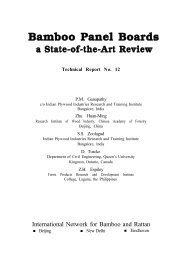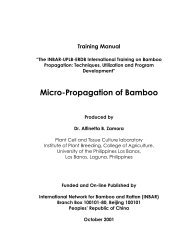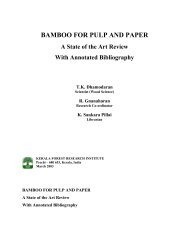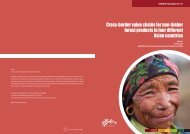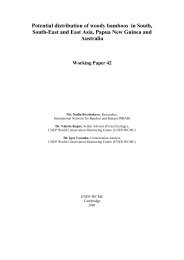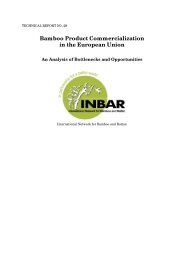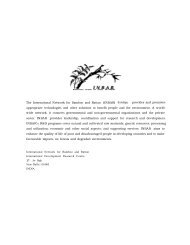The Bamboo and Rattan Sectors in Asia: an Analysis of ... - INBAR
The Bamboo and Rattan Sectors in Asia: an Analysis of ... - INBAR
The Bamboo and Rattan Sectors in Asia: an Analysis of ... - INBAR
Create successful ePaper yourself
Turn your PDF publications into a flip-book with our unique Google optimized e-Paper software.
In order to <strong>in</strong>crease <strong>in</strong>come <strong>of</strong> small-scale processors, there is need to enh<strong>an</strong>ce<br />
the development <strong><strong>an</strong>d</strong> availability <strong>of</strong> improved product designs that c<strong>an</strong> be replicated<br />
at the microenterprise level. To improve the <strong>in</strong>come-generation potential <strong>of</strong> bamboo<br />
<strong><strong>an</strong>d</strong> ratt<strong>an</strong> PCS, <strong>in</strong>terventions are needed to forecast market dem<strong><strong>an</strong>d</strong> <strong><strong>an</strong>d</strong> facilitate<br />
access <strong>of</strong> disadv<strong>an</strong>taged groups to those markets.<br />
Horizontal L<strong>in</strong>kages<br />
<strong>The</strong> studies found that the vertical l<strong>in</strong>kages are very strong <strong><strong>an</strong>d</strong> that horizontal<br />
l<strong>in</strong>kages are relatively weak <strong>in</strong> most PCS. Stronger l<strong>in</strong>kages among actors <strong>in</strong> the early<br />
stages <strong>of</strong> a PCS would help <strong>in</strong>crease barga<strong>in</strong><strong>in</strong>g power for producers <strong><strong>an</strong>d</strong> local traders.<br />
This could be done by provid<strong>in</strong>g tra<strong>in</strong><strong>in</strong>g <strong>in</strong> m<strong>an</strong>agement <strong><strong>an</strong>d</strong> other skills to<br />
cooperatives (not by creat<strong>in</strong>g monopoly cooperatives). As discussed earlier, the<br />
experience <strong>of</strong> the ratt<strong>an</strong> gatherers' associations <strong>in</strong> the Philipp<strong>in</strong>es provides a useful<br />
model. A variety <strong>of</strong> <strong>in</strong>centives were provided to encourage such associations (the<br />
most import<strong>an</strong>t be<strong>in</strong>g the eligibility for ratt<strong>an</strong> collect<strong>in</strong>g permits) that facilitate<br />
horizontal l<strong>in</strong>kages.<br />
Generally speak<strong>in</strong>g, improved horizontal l<strong>in</strong>kages <strong>in</strong> the <strong>in</strong>dustry appear to<br />
be beneficial <strong>in</strong> terms <strong>of</strong> <strong>in</strong>creas<strong>in</strong>g capacity <strong><strong>an</strong>d</strong> reduc<strong>in</strong>g tr<strong>an</strong>saction costs.<br />
However, the case <strong>of</strong> ASMINDO <strong>in</strong> Indonesia provides a warn<strong>in</strong>g that too much<br />
horizontal control c<strong>an</strong> be detrimental to the wider national <strong>in</strong>terests. <strong>The</strong> statutory<br />
market<strong>in</strong>g/export<strong>in</strong>g activities <strong>of</strong> ASMINDO seem to have had a negative impact<br />
on the susta<strong>in</strong>ability <strong>of</strong> the ratt<strong>an</strong> raw material production <strong>in</strong> the country. <strong>The</strong><br />
case <strong>of</strong> the KSBC <strong>of</strong> Kerala demonstrates that care is needed <strong>in</strong> design<strong>in</strong>g<br />
appropriate <strong>in</strong>terventions. Institutional mech<strong>an</strong>isms should be flexible <strong><strong>an</strong>d</strong><br />
responsive.<br />
Market Conditions<br />
It is clear that the various players <strong>in</strong> NTFP markets occupy unequal positions.<br />
<strong>The</strong> raw material producers tend to be the worst <strong>of</strong>f, with very little access to<br />
<strong>in</strong>formation about prices, quality requirements, tim<strong>in</strong>g <strong>of</strong> dem<strong><strong>an</strong>d</strong> or other <strong>in</strong>formation<br />
that would help them to pl<strong>an</strong> their m<strong>an</strong>agement <strong><strong>an</strong>d</strong> harvest<strong>in</strong>g <strong>in</strong> the short or long<br />
term. <strong>The</strong>y act purely as price takers, accept<strong>in</strong>g prices that are more or less equivalent<br />
to the wage value <strong>of</strong> their labor. <strong>The</strong> bal<strong>an</strong>ce <strong>of</strong> power could be shifted <strong>in</strong> favor <strong>of</strong><br />
raw material producers by improv<strong>in</strong>g market <strong>in</strong>stitutions. Interventions could <strong>in</strong>clude<br />
mak<strong>in</strong>g market <strong>in</strong>formation available along with other agricultural commodity price<br />
broadcasts <strong><strong>an</strong>d</strong> publications, develop<strong>in</strong>g <strong><strong>an</strong>d</strong> promot<strong>in</strong>g the use <strong>of</strong> appropriate ratt<strong>an</strong><br />
grad<strong>in</strong>g st<strong><strong>an</strong>d</strong>ards/rules, <strong><strong>an</strong>d</strong> perhaps develop<strong>in</strong>g ratt<strong>an</strong> (<strong><strong>an</strong>d</strong> other NTFP) auction<br />
markets where competitive bidd<strong>in</strong>g would help <strong>in</strong>crease raw material prices <strong><strong>an</strong>d</strong><br />
reduce other tr<strong>an</strong>saction costs. This would reduce the monopsony powers <strong>of</strong> the<br />
traders. In practice, collectors might still have to rely on traders to take their material<br />
to market, but the auction mech<strong>an</strong>ism would help move the price <strong><strong>an</strong>d</strong> quality criteria<br />
<strong>in</strong>to the public view.<br />
81



